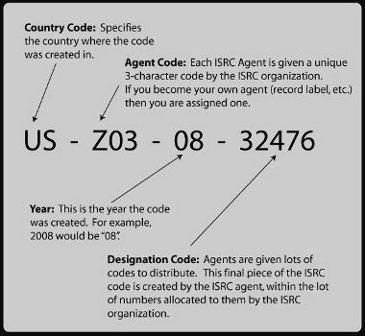
When a recording has an ISRC it can be uniquely and easily identified.
This is a first step in being able to manage recordings and associated revenues.
Producers of recordings assign ISRCs to their recordings to allow each recording to be clearly, unambiguously distinguished from other recordings across complex value chains
Digital distributors use ISRC within their databases and stores, linked to information such as reviews, and for sales reporting
Music Licensing Companies use ISRC to identify tracks and to implement track-based distribution and reporting
Broadcasters and webcasters use ISRC in their reports of the usage of recordings ISRC may also have a role in certain anti-piracy scenarios
With the transition to digital commerce, the ISRC has become increasingly important, as it can reliably identify recordings when data is exchanged between different proprietary systems.
BENEFITS
The ISRC system is the key to the administration of rights for sound and music video recordings globally in the digital environment.
- ISRC is intentionally standardised under ISO .ISRC is well established, widely accepted internationally and simple to use ,
- ISRC is compatible with many different databases, label copy systems, hardware electronics and digital communications standards
- Widely used formats such as CD and MP3 allow for ISRC to be carried alongside recordings
- ISRC allows for ‘interoperability’ of data between different organisations and systems
- ISRC is cost effective as it can be used without the need for investment in special technologies or equipment
ISRC is intended for use by producers and users of sound recordings and music videos.
Examples include record labels, as well as by copyright organisations, broadcasting organisations, libraries, licensees etc.ISRC is normally assigned to recordings by the first owner of the recording. Other parties that need to use ISRCs will usually obtain them from the owners of recordings.Recording owners assign ISRCs to their recordings, following a simple process. The ISRC system is designed to enable each distinct recording to be identified by a unique ISRC. To allow this, recording owners register to obtain ISRC Registrant Codes, which form the basis of the ISRCs assigned to recordings.Owners of recordings may for example be independent artists, record labels or recorded music groups. ISRC is available to all owners of recordings regardless of their membership (or not) with any industry association.- FOR OWNERS OF RECORDINGS, THE THREE MAIN STAGES ARE:
- 1 Obtain ISRC. In most territories, Registrant Codes are allocated to recording owners by the National ISRC Agency of that territory. Upon request, the National Agency supplies a Country Code and unique Registrant Code to the registrant.2 Assign ISRC. As described in the ISRC Handbook, the recording owner creates a unique ISRC for each track by appending the allocated Country Code and Registrant Code with a ‘Year of Reference’ and a unique ‘Designation Code’. It is strongly recommended that the registrant maintains good records of assigned codes.3 Use ISRC. Provide the assigned ISRC data along with other data about recordings.
- As part of the process of registering repertoire with MLCs it should be possible to register the ISRCs of recordings. When providing repertoire to digital platforms, directly or via an aggregator, ISRCs should be provided together with recordings and their associated data. Certain release formats permit ISRCs of recordings to be carried alongside the instances of the recordings.
- Once assigned, an ISRC remains permanently associated with the recording to which it is assigned, regardless of any changes in ownership or whether the recording falls into the public domain. The ISRC of a recording also remains the same if the recording is used across different countries.
An ISRC registrant should not assign ISRCs to recordings owned by another party.
ISRC should not be assigned if an ISRC has previously been assigned to the same recording. Instead the existing ISRC should be used.The assigned ISRC identifies the recording regardless of format or bit-rate differences. The ISRC of a recording should remain the same across different releases or formats.If the recording is licensed to another party or used across different countries, the existing ISRC of the recording should be retained and used.If the recording is licensed to other entities on different terms or different rights are licensed, the same ISRC still applies to the recording.ISRC is not used to identify compositions or lyrics, nor is it used to identify the products or releases (such as a CD or an MP3) that may contain an embodiment of a sound recording.It is expected that parties assigning ISRC will comply with copyright law.Normally this will require permission from the owner of any recorded material included within the recording.ISRC should be used to identify music video recordings.
A music video is different to a sound recording even if the same sound recording occurs in the video recording. This means that a separate ISRC must be assigned to the video recording.Separate ISRC codes must be applied to different recordings
(sound, music video and different versions)Different versions of music video recordings need to be assigned different ISRCs. Two music video recordings are considered different if their video content or their sound recording content is different.Historically, ISRCs have often been assigned to video recordings in a way that enables sound recordings and music video recordings to be distinguished from each other on the basis of the way the code has been assigned. This has arisen where national practice requires a way to distinguish between sound recordings and music video recordings, for example related to different treatment of rights.Historically, two methods of assigning ISRC to video recordings have been used. In the first method, one Registrant Code is used and sound recordings are numbered from 00001 upwards while music video recordings are numbered from 90000 upwards. In the second method the registrant uses one Registrant Code for sound recordings and a separate Registrant Code for music video recordings. A further and preferred method is to record which ISRCs correspond to sound recordings and music video recordings using a database.

No comments:
Post a Comment